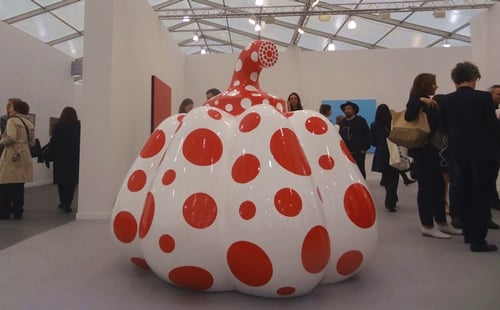

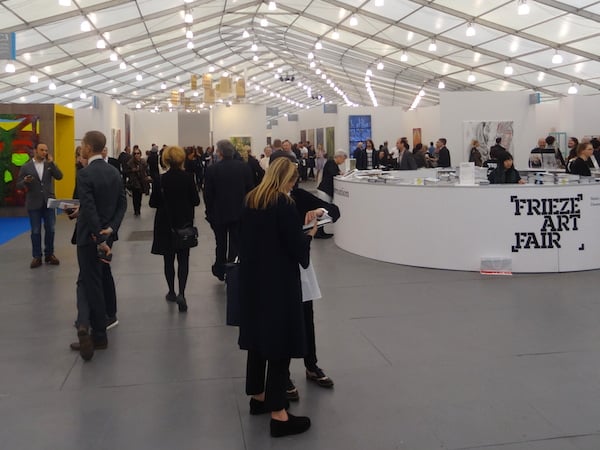
The north entrance of Frieze New York 2014.
Photo: Benjamin Sutton.
For Frieze New York, the third time is most certainly not the charm. The fair’s 2014 outing drew press and VIPs to Randall’s Island on Thursday, with the aisles of the vast Frieze Tent becoming jam-packed by the end of the day, but the booths, too, have succumbed to overcrowding. Since launching in 2012 Frieze New York’s greatest strengths have been its roomy, sparsely hung booths—tempering the exhaustion borne of navigating such mega-fairs—and the relative eclecticism ensured by the very international makeup of its exhibitors. But all that is starting to change, and not for the best.
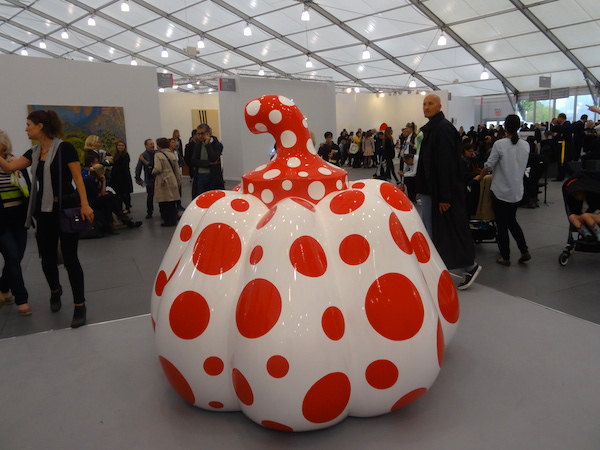
Yayoi Kusama‘s PUMPKIN (2014) in the David Zwirner booth at Frieze New York 2014.
Photo: Benjamin Sutton.
The 192 galleries involved in the fair’s 2014 edition are increasingly maximizing their wall space with ever-more homogenous works. The result is the flimsiest Frieze New York to date. The epitome of this comes at a major juncture near the fair’s south end, where competing mega-dealers Larry Gagosian and David Zwirner have adjacent booths; The former’s is lined with ho-hum Ed Ruscha text paintings, the latter packed with selections from the gallery’s roster. Zwirner easily wins the intersection, thanks in no small part to defecting Gagosian artist Yayoi Kusama’s giant polka dot-covered pumpkin sculpture, but the dueling dealers’ uninspired presentations mean we all lose. Luckily, a smattering of local galleries and others from cities outside the art world’s traditional axis of power are keeping things interesting with strong presentations of works by little-known artists and booth-filling installations.
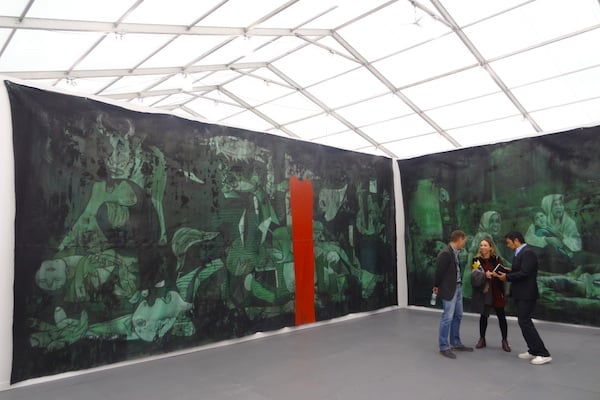
Dora Longo Bahia, Farsa – Picasso (Guernica) (2013) in the Vermelho booth at Frieze New York 2014.
Photo: Benjamin Sutton.
Foremost among these is the São Paulo gallery Vermelho, which has given over most of its booth to a pair of giant paintings on unstretched canvas by Dora Longo Bahia. One features a green-hued replica of Pablo Picasso’s Guernica splashed with a huge streak of blood-red paint, while the other shows a matching emerald-tinted scene of death and grief in which all the figures have been de-Cubist-ified and rendered more figuratively. It’s one of surprisingly few works at the fair overtly engaging with art history.
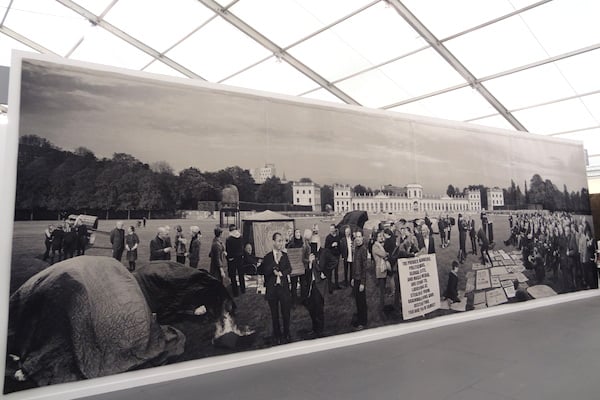
Goshka Macuga, Of what is, that it is; of what is not, that it is not 2 (2012) in the Andrew Kreps booth at Frieze New York 2014.
Photo: Benjamin Sutton.
Which isn’t to say that there aren’t other works on view memorializing contemporary art—after all, one of this year’s Frieze Projects is a re-staging of Allen Rupersberg’s 1971 hotel. Drawing on the more immediate past, New York gallery Andrew Kreps has brought one of two tapestries that Goshka Macuga produced for Documenta 13. The 38-foot-long piece shows the artist receiving the Arnold Bode Prize in Kassel in 2011 before a bevvy of art world power players—many of whom will no doubt be setting sail for Randall’s Island this week. Occupy Wall Street protestors seem to be crashing the award ceremony in Macuga’s cinematic, black-and-white scene, lending a little tension to the otherwise overly insider-y mega-quilt, which is on reserve and priced at $230,000.
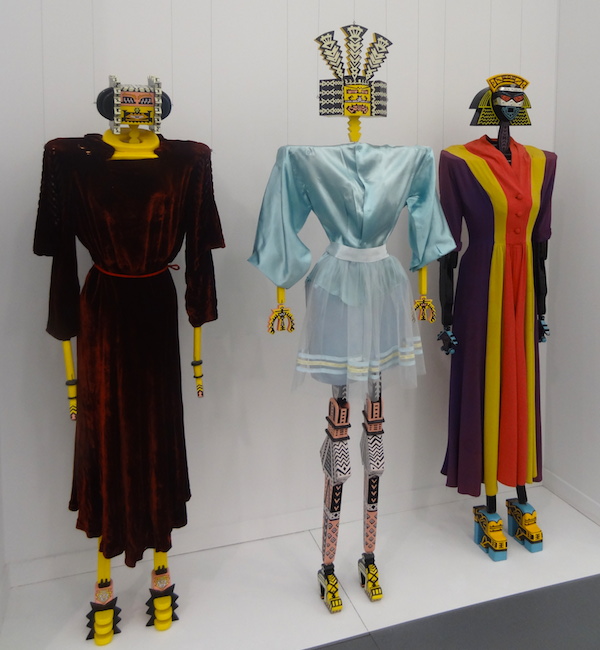
Works by Karl Wirsum in the Derek Eller Gallery booth at Frieze New York 2014.
Photo: Benjamin Sutton.
In a far more compelling historical presentation, New York’s Derek Eller Gallery has devoted its booth to Chicago Imagist Karl Wirsum, whose wild, sci-fi figures are an absolute delight. His three stylized mannequins—Mary O’Net, Chris Teen, and Nurse Worse (all 1972)—provide a nice contrast to the Isa Genzken mannequin sculptures on view a couple aisles over in the Hauser & Wirth booth.
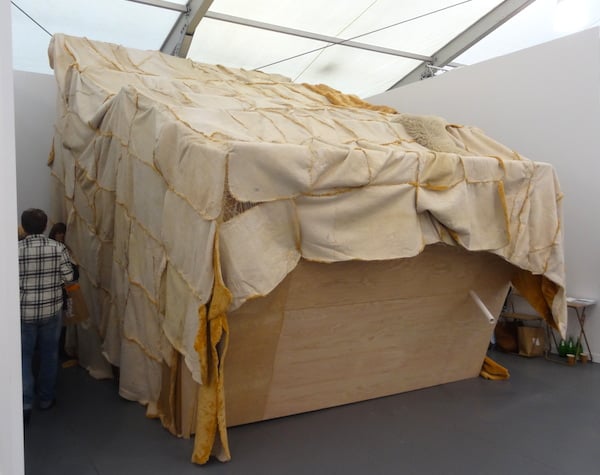
C.T. Jasper’s Sunset of the Pharaohs (2014) in Galeria Le Guern’s booth at Frieze New York 2014.
Photo: Benjamin Sutton.
Similarly conspicuous for its retro-futurist feel is the booth of Warsaw-based art space Galeria Le Guern, which contains an irregularly shaped video pavilion cloaked in lambswool by C.T. Jasper. The installation, and the video playing therein—an abstraction of Polish filmmaker Jerzy Kawalerowicz’s feature film Pharaoh (1966) in which all the human figures have been edited out—is one of the few offerings at this year’s Frieze New York that is genuinely transporting. The entire installation, titled Sunset of the Pharaohs (2014) is available for a relatively affordable $69,000.
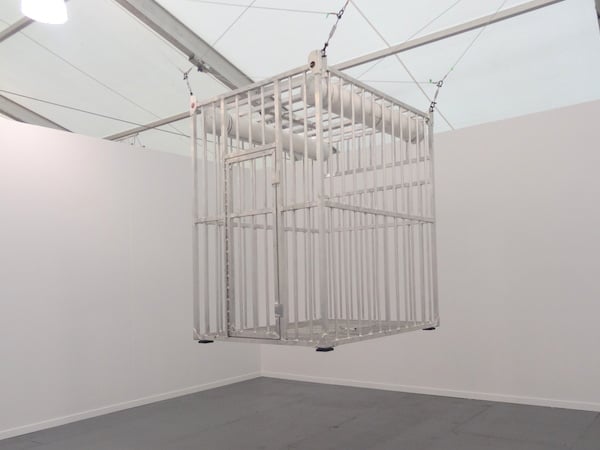
Wilfredo Prieto’s Shark Cage (2012) in the Nogueras Blanchard booth at Frieze New York 2013.
Photo: Benjamin Sutton.
It’s a testament to how bland this year’s offerings at Frieze New York are that the installation by Cuban artist Wilfredo Prieto in Madrid- and Barcelona-based gallery Noguera Blanchard‘s booth stands out. Amid all the over-stuffed booths, the artist’s simple installation of a suspended shark cage—a sculptural readymade named Shark Tank (2012) that the artist purchased from a treasure-hunting company—stands out for its sparseness. The Damien Hirst-like sculpture is on sale for $85,000.
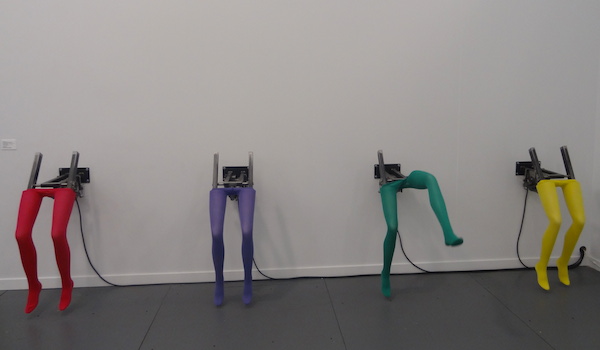
Jonathan Monk, All the Possible Combinations of Eight Legs Kicking (One at a Time) (2013) in Galleri Nicolai Wallner’s booth at Frieze New York 2014.
Photo: Benjamin Sutton.
A similarly irreverent installation can be found in Copenhagen-based Galleri Nicolai Wallner‘s booth, where Jonathan Monk‘s All the Possible Combinations of Eight Legs Kicking (One at a Time) (2013) has four pairs of mannequin legs, each clad in a different color of tights, kicking in sequence until every possible suite of kicks has been enacted. With the full range of possibilities playing out over 177 hours, the $110,000 installation (available in an edition of two) promises plenty of entertainment for your money.
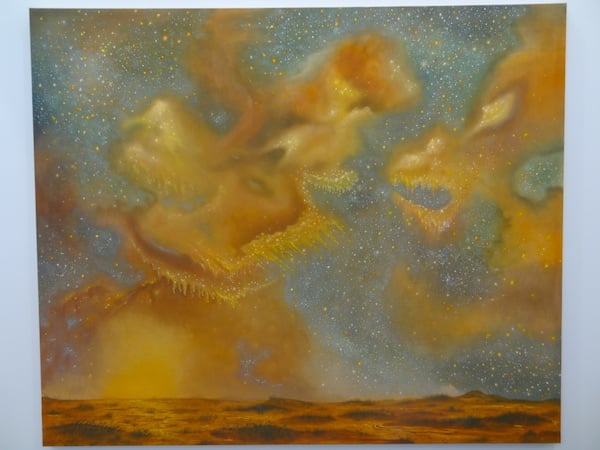
Jakub Julian Ziólkowski, Untitled (2013) in the Foksal Gallery Foundation booth at Frieze New York 2014.
Photo: Benjamin Sutton.
A conspicuous number of dealers filled their Frieze New York booths with the same exact sets of artists as last year, giving the whole fair the feel of reheated leftovers. But this strategy paid off for the Warsaw-based Foksal Gallery Foundation, which once again wowed with strange and beautiful paintings by Jakub Julian Ziólkowski, among others. Sadly, though, this was the exception to the rule, reinforcing the overwhelming sense of staleness at Frieze New York 2014.
The 2014 edition of Frieze New York continues on Randall’s Island through May 12.
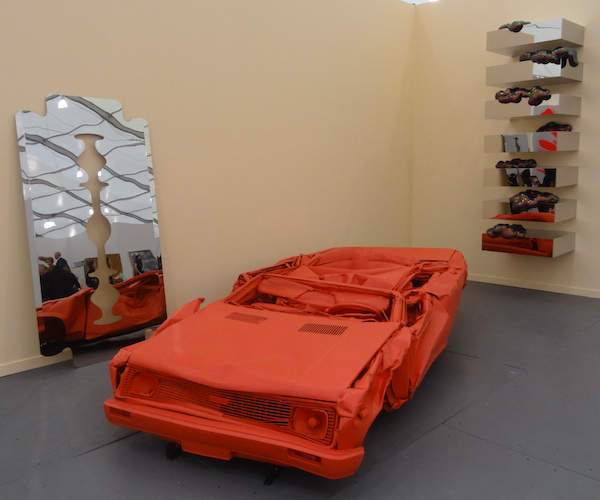
Works by Sylvie Fleury in the Salon 94 booth at Frieze New York 2014.
Photo: Benjamin Sutton.





